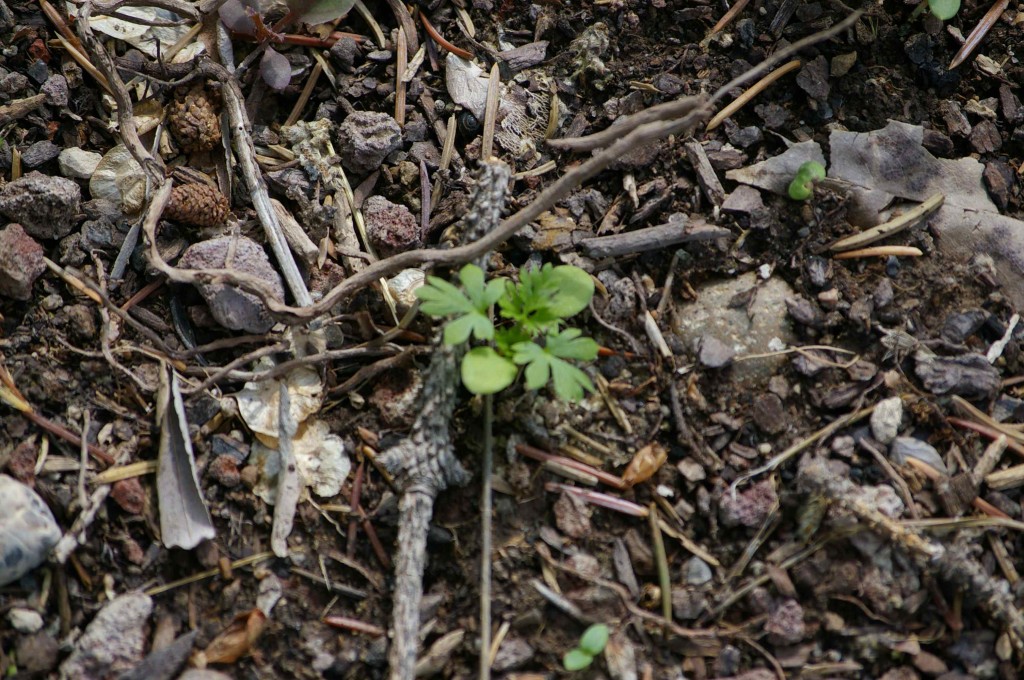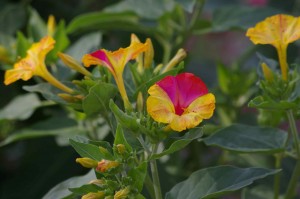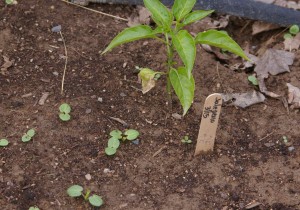Spring in southwest Idaho brings an exciting wave of green to our yards. One challenge for me is to separate the weeds from the desirable volunteer seedlings. These volunteers reseed and establish in unexpected places, teaching me along the way about which conditions they prefer and what time of year I can actually plant my own seeds. They tend to be much smaller than the weeds and/or their first leaves are often different than the full grown plants that I’m used to seeing for 99% of the growing season. Even after weeding, I must often thin the masses of volunteers. Sometimes, depending on the plant, I can transplant a few for design reasons, but mostly I just leave them where they are, enjoying the casual air they give the gardens.
Here are a few pictures of volunteers I have had this year.
Balsam impatiens (above) reseed prolifically, but pull easily. They bloom in the heat of summer on up the stalks of 3-4 foot plants. Here is a picture of them in my front flower garden last year (Middle back, dark pink and purplish flowers). Most of this garden gets full sun up until the evening. I don’t think the balsam impatiens are quite in full bloom yet and none of the lighter pink shades are there.
Below is a volunteer bleeding heart left to grow for now amongst my freshly planted nasturtiums. This is an example of something that has never in 15 years volunteered for me before. This year I have a couple of volunteers. It can’t stay there for long, so the plan is to let another family adopt it.
Next, is the crimson rambler morning glory volunteer. They need to be thinned as soon as they begin to appear and they NEED something to climb or they will smother the rest of the plants, but they are also easy to pull and reward me with a profusion of dark pink blooms in the heat of summer. These will be allowed to climb the rock wall just to the left of the pot.
The heavenly blue morning glory does not reseed as heavily and the vines are not as jungle-like, but they are always reliable. The seedlings are fun, with their blue veins. The first leaves remind me of drawings of teeth with roots showing. In the picture below you can also see volunteer petunias that I was surprised with this year. These were petunias that I had grown from seed myself the previous year. It seems that volunteers are most likely from plants I have grown from seed myself.
Here are the blooming heavenly blue morning glories just beginning their summer climb; and petunias in a pot.
I started rudbeckia in my greenhouse last year, thinking it was a tender annual. I was pleased when the plants not only survived our harsh winter, but scattered volunteers about their bases. Their yellow blossoms are a delicate yellow. Volunteers in the second photo.
The rudbeckia seedling is in the center with it’s fuzzy leaves. To give some perspective on size, the round white paper like elm tree seeds are about 1/4 inch diameter. The succulent seedlings are portulaca, or moss rose. They are teeny tiny when they first sprout. I have grown they from seed, but they do reseed easily from plants I have purchased at the nursery, too. They are some of the last volunteers to appear, but they are fast growing and well worth the masses of heat loving crepe paper flowers. Below (last year) they are just taking off and still need to be thinned. They stay very low to the ground, so fill nicely under other plants and like to grow along the hot cement.
The volunteer larkspur below is unusually isolated. Notice that the first leaves are roundish, while the true leaves have a feathery look to them. These volunteers also fall into the category of prolifically reseeding, but easy to pull.
Here is a bunch of them full grown and in bloom. They are the tall purple and white flowers:
The first leaves of the annual four o’clock are plump propellers that are fairly obvious. They will grow into a bush like shape, so definitely need to be thinned. The trumpet shaped blooms are abundant.
The foliage of the perennial horned poppy, as seen in the young, two inch across, volunteers below, is soon to be graced with cheerful orange blooms. Keep these under control early. I have been able to transplant them if I take a sufficient clump of soil with it and don’t disturb the roots.
Here is what happens if you don’t thin your double shirley poppies at an earlier stage, but I plan on doing it soon. This is one kind of flower that I have only had from volunteers for years. I eagerly await the blooms.
One plant turned up with the white edges and I saved seed from it, but have yet to propagate it.
Lastly, here are some ubiquitous hollyhock volunteers, looking innocent at the moment. I have already thinned huge numbers of these, which grow into beautiful giants. It is best to get these while they are small, before the root system has developed. My jalapeno plant wouldn’t stand a chance.
There is nothing quite like hollyhocks along a fence. Now, you’ll have to excuse me. I need to go ruthlessly thin some volunteers.






















I love finding volunteers in my garden. This year I had volunteer spinach and sunflowers in unlikely places. 🙂
I love how you interspersed the pictures of the young volunteers with the adult plants in bloom! (Although at first I thought you were going to talk about ‘knowing your (human) volunteers’ … 😀
It’s so fun when you use some of the pictures I’ve taken 😀 You have all the credit for the plants actually growing, though 😛